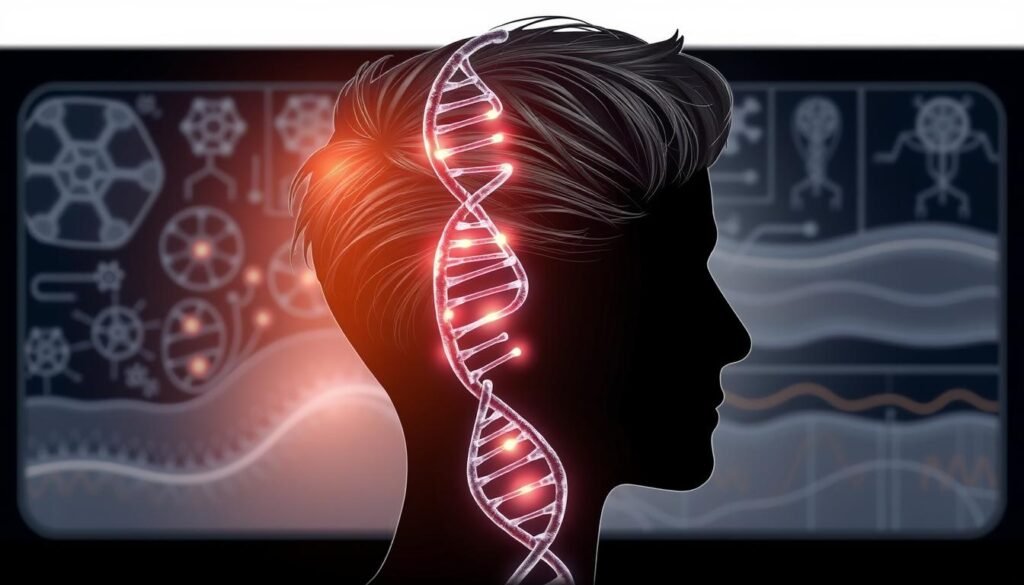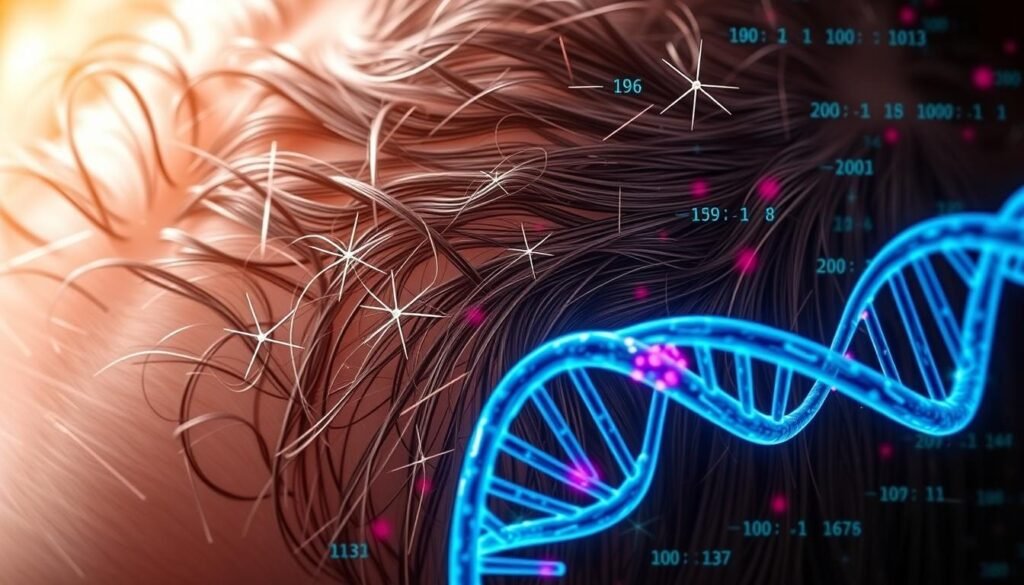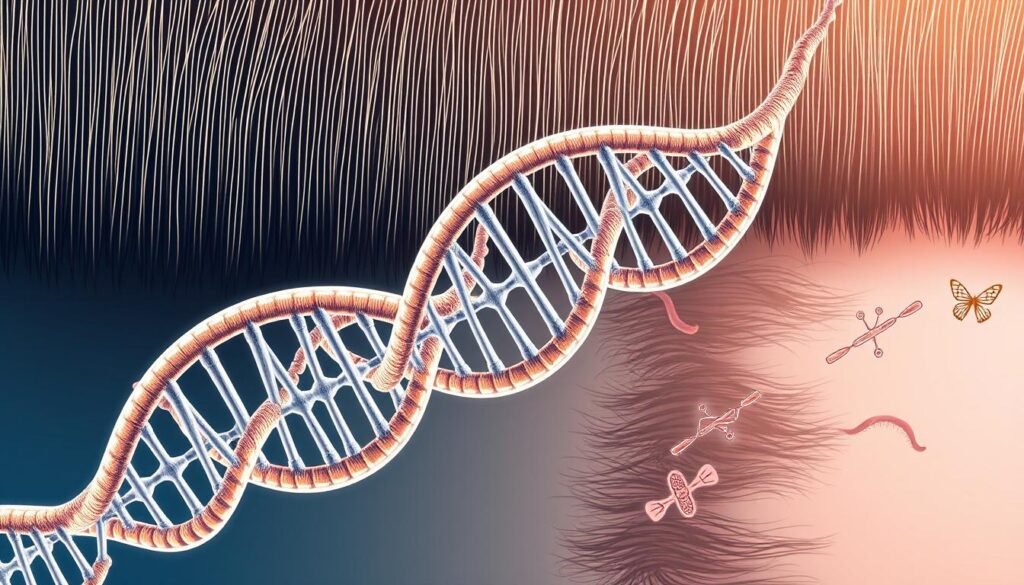Nearly 80 million Americans face genetic hair loss. This issue touches both men and women. It shows that genes play a big part in hair loss. It’s not just about getting older. It’s about what we inherit from our families. Knowing this can change how people deal with hair loss and seek treatment.
Scientists are learning more about the genes linked to hair loss. These discoveries could lead to new treatments. Understanding these genetic connections helps us tackle hair loss better.
Key Takeaways
- Hair loss affects a significant portion of the U.S. population, emphasizing genetic influences.
- Understanding the genetic factors in hair loss can help individuals recognize personal risk.
- Hereditary conditions related to hair loss are often passed down through generations.
- Ongoing research aims to unveil the complexities behind hair loss inheritance.
- A healthy lifestyle can support hair health, alongside genetic considerations.
- Exploring effective treatments may provide hope for those experiencing hereditary hair loss.
- Learn about the connection between diet and hair health at this article.
Understanding Hair Loss
Hair loss can hit anyone, regardless of age or gender. It’s key for anyone noticing changes in their hair. Different issues can cause hair to fall out. Spotting these is the first step towards treatment. It’s important to figure out if genetics play a role.
Types of Hair Loss
There are many kinds of hair loss, each one different. The main ones include:
- Androgenetic Alopecia: Also known as pattern baldness, it features slow thinning at the crown or hairline.
- Telogen Effluvium: Caused by stress or changes in your health, this type means you lose more hair than normal.
- Alopecia Areata: This autoimmune disorder causes patchy hair loss. It can strike any area with hair.
Each type has its own signs and reasons. They often come down to genes or environment.
The Importance of Identifying Hair Loss
Finding hair loss early can really help manage it. Knowing why you’re losing hair is essential. Is it genetics or your surroundings? This affects your treatment choices. It helps you plan and may bring up family health patterns.
Spoting hair loss types is a basic step in tackling the problem. Diving into the causes can make treatments more effective. That leads to healthier hair over time.
Genetic Factors in Hair Loss
It is important to understand the genetic aspects of hair loss for anyone worried about their hair health. Genetics plays a big role in how our hair grows and its quality. Traits passed down from our parents can affect hair thickness and how long it stays on our heads. Many conditions linked to genetics are behind hair loss, showing its deep impact.
How Genetics Impact Hair Growth
Genetics significantly affect how our hair grows by controlling the hair cycle and follicle life. Certain genes create different hair loss patterns and make us more likely to get conditions like androgenetic alopecia. Studies have identified crucial genes that influence our chances of facing hair loss. Knowing these genes improves our understanding of hair health and directs us to better treatments.
Common Genetic Conditions Leading to Hair Loss
There are many genetic disorders that cause hair loss. Each has its own features and genetic causes. Some examples are:
- Androgenetic Alopecia: This is the most common type of hair loss, where you see a gradual thinning of hair.
- Turner Syndrome: A condition in females that may cause hair to fall out due to hormone problems.
- Keratinization Disorders: Rare diseases that lead to a lot of hair loss because of abnormal keratin.
Finding out about these conditions helps tailor treatments for hair loss. For those curious about genetics and hair health, the Journal of Investigative Dermatology has more detailed research.

| Condition | Impact on Hair | Inheritance Pattern |
|---|---|---|
| Androgenetic Alopecia | Gradual thinning of hair | Autosomal dominant |
| Turner Syndrome | Possible hair loss due to hormonal changes | Non-inherited (occurs during development) |
| Keratinization Disorders | Severe hair loss | Autosomal recessive |
The Role of Heredity in Hair Loss
Heredity is key in determining if you might lose hair. It affects not just when hair thinning starts but also how severe it gets. Both your mom’s and dad’s genes play a role in hair loss, so knowing your family history is important.
Studies show if your parents have thinning hair, you’re more likely to have it too. This means you might start losing hair quicker or get bald spots. Looking at your family’s hair loss patterns can give you clues about what to expect for yourself.
To figure out your risk, you need to understand how hair loss is passed down. Here are some key points:
- It’s about many genes, not just one.
- Hair follicles react differently to hormones, especially androgen.
- The older you get, the more likely you are to lose hair.
Here’s a quick look at how family history affects hair loss risk:
| Family History | Increased Risk of Hair Loss |
|---|---|
| Both Parents with Hair Loss | Significant Increase |
| One Parent with Hair Loss | Moderate Increase |
| No Family History | Lower Risk |
In short, heredity is a big factor in hair loss. Keeping an eye on hair loss in your family can help you get ready for possible changes in your hair.
Hair Loss Genetics: What the Research Says
Studies have made big strides in understanding hair loss genetics. They’ve looked into how genes play a role in hair loss. Findings highlight the specific genes that impact hair growth and loss.
Key Studies on Genetic Predisposition
Many important studies have dug into the genetics behind hair loss. They use genome-wide association studies (GWAS) to find genetic markers linked to baldness. For example, changes in the AR gene might make hair loss more likely.
These studies reveal the complex relationship between our genes and losing hair. They help us see how genetics influence this issue.
Uncovering Genetic Markers for Hair Loss
Finding genes linked to hair loss helps us get why it happens. Some markers can even predict who might lose their hair. Research has shown connections between single nucleotide polymorphisms (SNPs) and hair loss.
This research into genetics offers clues about who is at risk for hair loss. It could lead to new ways to prevent it.

Understanding Genetic Hair Loss Causes
Genetic hair loss causes are a major concern for many. Hereditary hair loss comes from genetics and hormones. Understanding these factors helps us see why hair growth gets messed up.
This leads to male-pattern and female-pattern baldness.
Several genetic disorders contribute to hair loss. For example, polycystic ovary syndrome (PCOS) changes hormone levels. This hurts hair follicles.
Genetic predispositions might show up as gene mutations. This affects how hair roots work and grow.
Figuring out the specific causes of genetic hair loss is key. If you’re losing hair fast or all the time, see a doctor. For extra info on hair loss and its causes, visit this resource.

| Condition | Genetic Influence | Symptoms |
|---|---|---|
| Male-Pattern Baldness | High heritability (up to 80%) | Thinning at the crown, receding hairline |
| Female-Pattern Baldness | Moderate heritability (around 50%) | Diffuse thinning, widening part |
| Polycystic Ovary Syndrome (PCOS) | Genetic predisposition, hormonal level fluctuations | Thinning hair, increased body hair |
Understanding these genetic hair loss causes helps us. It allows us to explore treatments. This way, we can lessen the impact of hair loss in our lives.
Hereditary Hair Loss: A Closer Look
It’s important to understand hereditary hair loss for anyone worried about losing hair in the future. This type of hair loss, known as pattern baldness, follows a genetic pattern seen in families. It shows how complex pattern baldness inheritance is with various factors.
Pattern Baldness and Its Inheritance
Pattern baldness hits men and women differently. Men often see it start at the hairline or crown. Women tend to have thinning all over their scalp, not just a receding hairline. Your genes play a big role in if you’ll see this kind of hair loss. Looking at your family history of hair loss helps figure out your risk. Some family patterns make hereditary baldness more likely.
Evaluating Family History of Hair Loss
Looking into your family’s hair loss history offers clues about your own chances. Talking to relatives about baldness gives a clearer genetic risk picture. A doctor or genetic counselor can then help understand these risks better. For more info, check out this link here.
Genetic Predisposition to Hair Loss: Are You at Risk?
Understanding your genetic risk for hair loss is key. Many people don’t think about how family history plays a role. Studies show those with family members who have lost hair might face the same fate.
Using family pedigree charts can show inherited traits more clearly. This shows if hair loss runs in the family. By mapping relatives’ hair loss, you can guess your own risk better.
There are tools and genetic consultations for those who want to delve deeper. These services review genetic markers linked to hair loss. They also provide tailored advice on handling or preventing it.
Let’s quickly go over how genetic risks work. Below is a table that lists common genetic factors related to hair loss:
| Genetic Factor | Relationship to Hair Loss |
|---|---|
| Androgen Receptor Gene (AR) | Influences sensitivity to hormones linked to hair loss. |
| Keratin-Associated Protein (KAP) | May alter hair structure and strength. |
| ELN and COL4A3 | Associated with connective tissue and follicle health. |
| WNT Signaling Pathway | Regulates hair follicle development and cycling. |
Knowing about these genes can help people make smart decisions for their hair care. In turn, they might see better results in maintaining their hair health.
Genetic Testing for Hair Loss: What to Expect
Genetic testing for hair loss has become more common. People want to know why their hair is thinning. These tests look at your DNA to find markers linked to hair loss. This gives clues about if you might lose hair because of your genes. Usually, it starts with a sample of saliva or blood. You can do this at home or a clinic, and then you send it to a lab for analysis.
How Genetic Testing Works
The tests use advanced techniques to study your genes. One method is called SNP analysis. It checks many genes related to hair growth and loss. Once your sample is studied, the results show if you are likely to get common types such as male or female pattern baldness. You should get your results in a few weeks. They will tell you about your genetic risks.
Interpreting Genetic Test Results
Understanding your test results is key. Most reports show if you have markers linked to hair loss. This helps you know your risk level. Remember, these results suggest what could happen, not what will happen. Talking to a doctor or counselor can help. They can guide you through your results. Together, you can make a plan for preventing or treating hair loss.